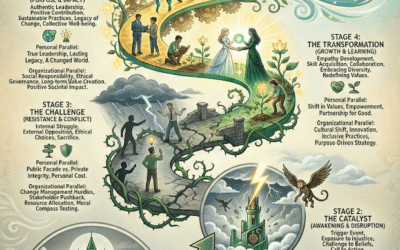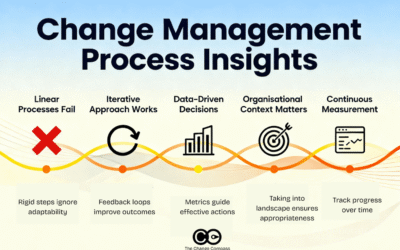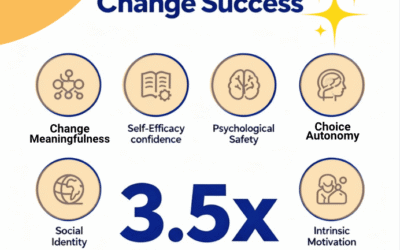Recently, with the relentless pace of work, the changing weather conditions, and inadequate sleep, I had caught a cold. In recovering from the cold I started wondering more about the whole life cycle of sickness and wellness. Could it be that we can leverage from medicine how we improve the health of the organization as we design the change management process? In many ways, organizational health and well-being can be an analogy to how healthy a human being is. If the health of the organization is not great due to various imbalances in the system, it can fall ill and become less effective, thereby not meeting its goals, which is a topic often discussed in various organizational health blogs.
So how may we leverage the clinical approach that medicine adopts to disease treatment and maintenance of health to how we approach change management for positive change? In Medicine, the approach is based on the diagnosis, treatment, and prevention of disease. Let’s use these three phases to further understand what this approach means when applied in a change management context.
Diagnosis
One of the most important parts of being a medical practitioner is the ability to establish rapport with a patient. We have all been to doctors who spend barely 5 minutes with us and quickly subscribe pills before moving on to the next patient. Whilst the ramifications of limited rapport may not be great with a minor ailment, with complex diseases lack of rapport may result in the wrong diagnosis as important detail may have been missed or not prompted.
To effectively diagnose a patient the medical practitioner begins by taking the medical history before commencing on a physical examination. In a similar way, to really understand what is going on in the organization and why it needs to change we need to understand where it has been. Can an organization’s history can tell us why it is in the position that it is in currently? What are external factors? What has worked or has not worked in the past in undergoing change? What best practices have been used? Have there been incidents where change outcome was disastrous? What were the lessons learnt? What leadership style or ways of engagement has worked?
Similar to undertaking a physical examination, it is also important to analyze what conditions the organization is in currently prior to implementing a change. How effective are different levels of leaders is driving and engaging their teams on change initiatives? Is there any ‘signal loss’ in cascading information up and down or across the organization? What have been some of the common stories told about change? What systems are in place to support change initiatives? For example, change champions, communication channels or learning processes.
Diagnostic tools
Physicians leverage diagnostic tools in diagnosing a patient’s illness. This is based on what is presented by the patient and the physician’s overall assessment based on visible or inferred observations. For example, the DSM-5 is the Diagnostic and Statistical Manual of Mental Disorders that is used to diagnose psychological and psychiatric disorders. The physician does not blindly follow the diagnostic tools to formulate an assessment. In the same way in diagnosing the organization we should also seek to understand first and then make the diagnosis based on evidence (inferred or observable). In this way, we should not blindly follow a particular change framework in ‘diagnosing’ the organization as this depends on the organization as well as the chosen change framework.
In change management we do not have just one diagnostic tool, we have several frameworks in which to help our diagnosis. There is no one framework that is applicable in all situations. Different models may be useful in certain situation. The trick is to know which ones to leverage in the right type of situations. There are various models such as the Mckinsey STAR model, systems theory, SWOT analysis, nudge theory, or force field analysis to identify key issues across the organisations. Here, we focus on some of the more ‘change-specific models’.
John Kotter’s theory (8-step model) is great when applied to a significant strategy execution, restructuring or organization-wide change. In these situations, the strategy vision clarity has to be clear, a clear sense of urgency created and understood, and strong leadership coalition to drive through any employee resistance to the change. With this type of significant change leaders need to continuously drive and reinforce the change, and integrate this within the ways of working within the organization.
However, when the organizational change is more of a project such as a technology or process change, then the Prosci ADKAR change management model (Awareness Desire Knowledge Ability Reinforcement) model may be more relevant. This is a process focused model that aims to transition an individual from the current situation to the new state. Key enablers or activities may be executed on to help drive this transition. These include providing the right communications, addressing any employee inputs, training sessions, coaching and recognition for the right behaviors adopted.
When the change involves significant restructuring where there could be redundancies including role changes and people transitions then the Kubler-Ross model may be leveraged. The model outlines an individual’s emotional journey through loss and stages of grief during the change process. The journey starts with shock, denial, then frustration, depression, experimentation and finally decision and integration. As often with significant people transitions and job redundancies emotions are high and these need to be carefully addressed and managed. However, if the change is more focused on a simple process change where there is not a lot of heightened emotional reactions, this model may not be as useful.
The change practitioner is not always engaged or consulted at the beginning of a change initiative. Sometimes it is only when things are not going well and according to plan that the change consultant is engaged to turn things around. Irrespective of whether the change initiative is in the commencement or in the middle of the journey, effective organizational diagnosis is important to understand exactly what change intervention is required to address the situation. You may need to conduct focus groups as a part of employee engagement to get this data, and depending on the measurement model you take a Likert system analysis may be used.
Just as a good medical practitioner will utilize a combination of evidence/data and judgment according to diagnostic frameworks to determine the best course of treatment, the change practitioner should also follow suit. What types of data should be used to not only diagnose but also to subscribe treatment? The following is a summary of key types of data to look for and collect.
What is the change
– Why is the organisational change necessary?
– What does the change benefit? Its customers or its employees?
– What does the end state look like?
What is the impact
– Who is impacted by the change projects?
– What is the extent of the impact?
– What are the impacts on the role/person/organization? How does it affect organizational culture, organisational structures or organizational performance?
– What time period is the impact? In what ways?
– What are the change transition activities proposed?
Readiness for the change
– How ready are the impacted people for the change? What is the organisational diagnosis?
– How is this measured and reported for change management metrics?
– What is the minimum readiness criteria?
A good physician looks at the patient as a whole and not just the particular symptoms he or she is presenting. Based on the the symptoms presented, it could be that there are several disorders and not just one. In a similar way, a change leader needs to understand what the total picture of change in doing an organisational diagnosis is and not just isolate change to one project. Understanding what the totality of changes mean to the impacted stakeholder will go a long way in deriving what change approach or support is required.
To effectively diagnose a change situation the practitioner needs to use a data and evidence-based approach to understand where the organization has been, where it is and where it is going. Again using data, the practitioner needs to effectively frame the problem and diagnose the situation using the appropriate change model/framework(s). The right diagnose is critical to ensure the right change intervention is subscribed. For the same reason that wrongly diagnosing a patient could lead to further illness the same can be said for the wrong diagnosis of the change situation for an organization.
—————
If you enjoyed this article please share this with your contacts.






